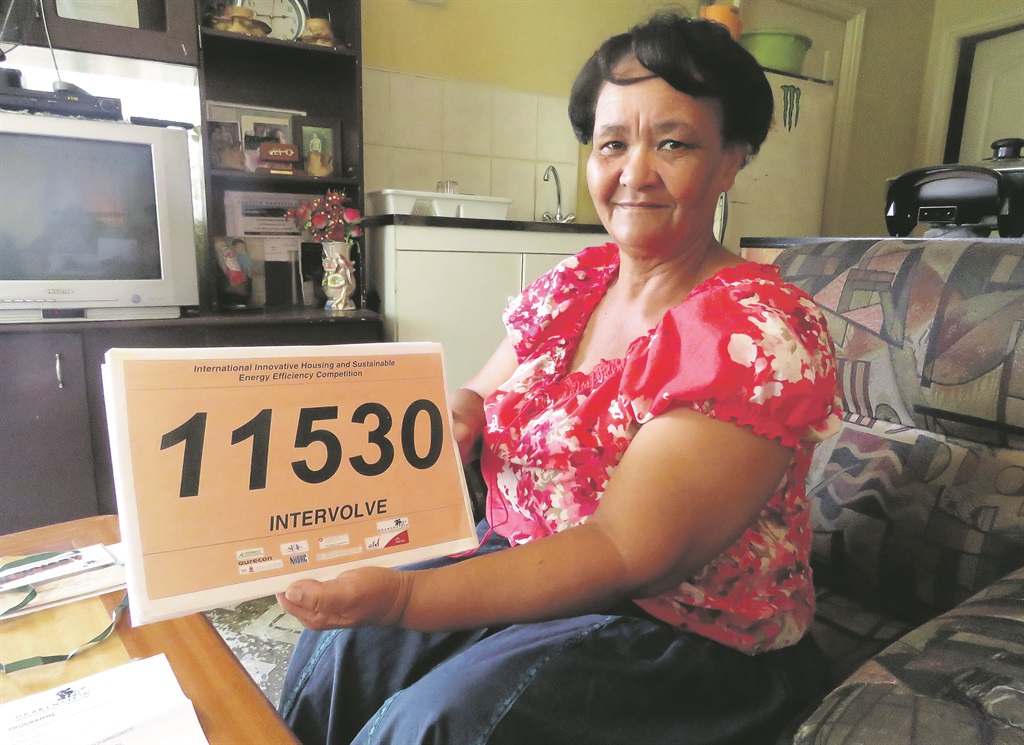
Six years and eight months ago, Wilhelmina Reitz moved into her government-issued, low-cost house in Maylaan, Wellington. But for her, it feels like it was yesterday.
“I have changed nothing in this house since I got it. It’s nice to stay here,” Reitz says. Along with other beneficiaries, she received the keys to her new home on February 9 2010. The houses changed the face of Maylaan, which was previously littered with shacks.
The homes were built by government in partnership with the Drakenstein municipality, the National Home Builders’ Registration Council (NHBRC) and others using innovative building technology developed in the Netherlands called Veerhuis, to build ecofriendly, low-cost, energy-saving and high-quality houses suitable for all climates.
On a hot Sunday afternoon in early October, Reitz’s front door is ajar, but the lounge is empty. A cellphone lies on the armrest of a couch, while country music wafts from a stereo.
A knock on the door brings a welcoming Reitz, who explains that her English isn’t good – her language is Afrikaans – but she will try her best. She sits on one of the couches, the one facing the door.
In her hand is a torn brown A4 envelope, but its contents are clean, as if they have just been printed.
The stack of papers includes her handover certificate, a tag on which is written “beneficiary”, the programme of the official handover ceremony and information about the innovative building techniques used for the house.
The 65-year-old mother of two is all smiles as she sits on her couch, which gives her a clear view of the street outside her corner-stand house.
“I spend most of my time in the lounge, on this couch. I sit here and watch TV or listen to the radio. When I sit here, I am also able to see all the people who come in and those walking past in the street,”
she says.
Outside it’s close to 30°C, but Reitz’s home is cool. “It is nice here. When it is winter, it is not cold. It is warm. I’ve got no complaints about this house. And in summer, it is cool. And I don’t have to worry that it will rain in.”
Before 2010, for six years, Reitz had lived in a shack with her daughter and son. Then the houses were completed and the keys were handed over to the family.
“It was a big change for me because when it was raining then, the rain would come into my shack. The kids would call me from work because the house had been flooded, and I would have to return home. That is all gone now,” she says, her face lighting up.
In January 2011, almost a year after moving to her home, Reitz retired. She had spent 23 years working at a bag-in-box packaging factory.
These days, she does domestic work for two days a week. On the other days “I am at home doing my own work of cleaning my house, washing clothes and preparing food for the kids”.
Two streets away, a light-beige corner-stand house is the home of Lecruicia Pienaar (30), which she shares with her two daughters, Cassidy (8) and Chaylon (1), and her husband Sullivan.
Pienaar inherited the house from her mother, who died in March last year. The family also received their house from the municipality in 2010. Her late father had applied for a house and was on the waiting list. Sadly, he died before the houses were built.
For almost two years during construction, they rented a living space in another section of Maylaan and, Pienaar says, she and her mother lived in fear of being victims of crime.
“It was difficult to live there because the people [landlord] always wanted more and more money for electricity. So, we lived there for two years and weren’t happy because there were always robberies and people who wanted to harm us. It was scary in the daytime, we had to close all windows and doors because there were tsotsis always walking around.”
But when they heard that the houses were finished and they were going to move in, Pienaar says her mother was so happy. “My mother told me to leave the old things behind because we were going to a new house.
“It changed our lives. It was a big change for us because … suddenly we didn’t have to be afraid any more. We came here and I was excited because
we had our own house. I don’t know how to explain it.
I can’t express my feelings of how I felt at first. I was happy, I was happy to move from there.
“My mother was always afraid when Cassidy was playing outside at the previous place, because you never knew what could happen to her. That’s why my mother said we should leave the old things behind and we would buy new things for our new home,” Pienaar says.
All that is in the past now, and the two siblings are able to play in their own yard while the close-knit community keeps watch over them.
When they finally moved into their new homes, Pienaar says, the community was joyful. People were happy to be reunited with their old neighbours following two years of living in separate parts of the area during construction.
Pienaar’s home, however, is on the edge of Maylaan, where an informal section begins. The shacks are congested and overcrowded, and plenty of illegal activity is suspected.
Tik-smoking is cited as one of the problems. Unknown cars often park in front of people’s properties on the developed side, and people are seen buying suspicious-looking items late at night.
The night before, police put the area under lockdown while they searched people for drugs and other contraband. Several were arrested.
“I don’t know what to do about [the illegal activities],” Pienaar says. It is one of the things that makes her unhappy about her neighbourhood.
But overall, “the people here are good and we live well together”.
The technology used in the building of the houses is known as Veerhuis (feather house) and was developed in the Netherlands.
- Ecofriendly, low-cost, energy-saving
materials - Produces seven times less greenhouse gas
- Healthy and safe
- Requires little maintenance, but is of a high quality
- Suitable for all climates
THE MATERIAL
- Called Expanded Polystyrene (EPS), which originates from crude oil
- May be the only oil derivative that helps to protect the environment and save resources
- Insulation products from EPS save energy for both heating and cooling
- Fully recyclable and reusable
WHY EPS?
- Strong
- Easy to handle without the use of heavy-duty machines
- Doesn’t burn easily
- Insulates outside temperatures – both hot and cold
- Ecologically inactive, recyclable and reusable even after a lifetime
- Requires minimum maintenance
- Doesn’t require expensive tools in the construction phase
- Leads to speedy construction and can easily be expanded
- Light in weight and can be built on nearly
every surface - Can be produced locally, and thus can create jobs
- Hygienic and doesn’t disintegrate
- Cannot rot and gives no shelter to fungi
- Resistant to frost
- Has no caloric value for rats, mice or termites and doesn’t smell
- Doesn’t emit poisonous gases or fine dust and is not an irritant for the skin
- Easy to handle with simple instruments
- Can be delivered in prefabricated modules and assembly is very simple, hence it doesn’t require highly trained workers and is relatively cheap
- In production, only half the energy is used compared with alternative materials
ADVANTAGES OF THE VEERHUIS TECHNIQUES
- Construction is resistant to earthquakes and hurricanes, and is fire retardant
- It is simple and training can be achieved in 10 days
- Construction of the building is four to five times faster
- Extensions or additions can be implemented in all directions without any incident
- No need for heavy machinery
- Fewer lost-time accidents
- Fewer occupational health problems
- Globally applicable
- Because 95% of EPS is air, it is necessary to produce it locally, which is simple and not expensive. In turn, it can lead to job creation, poverty reduction, investment, local training and transfer of knowledge




 Publications
Publications
 Partners
Partners








